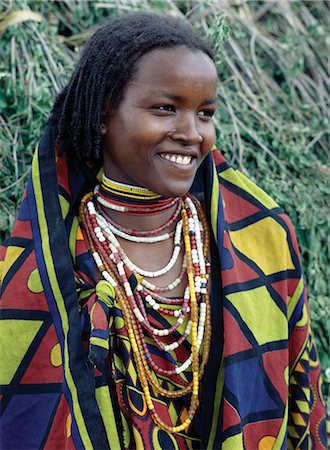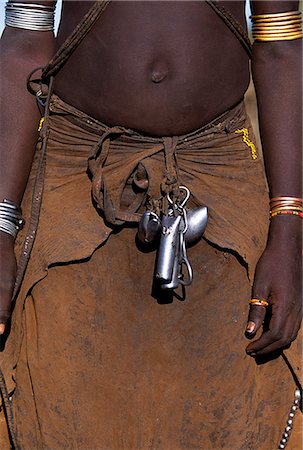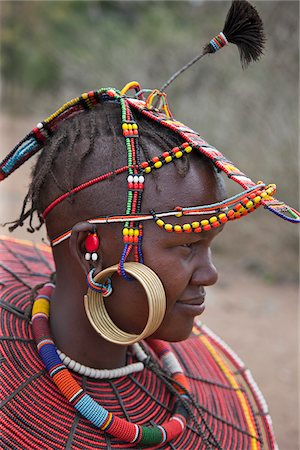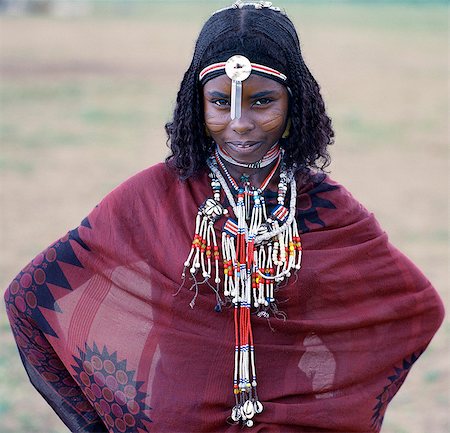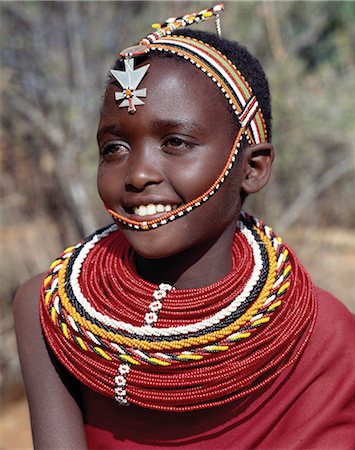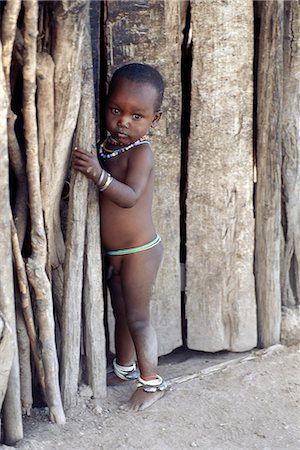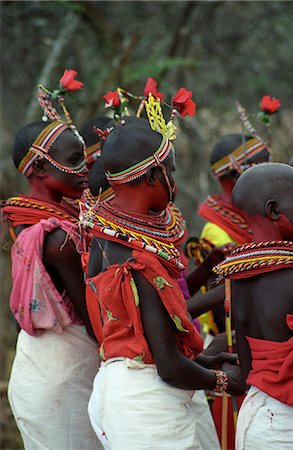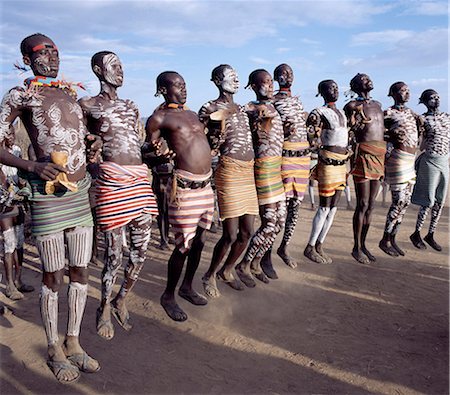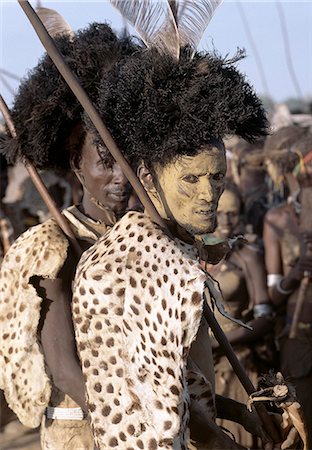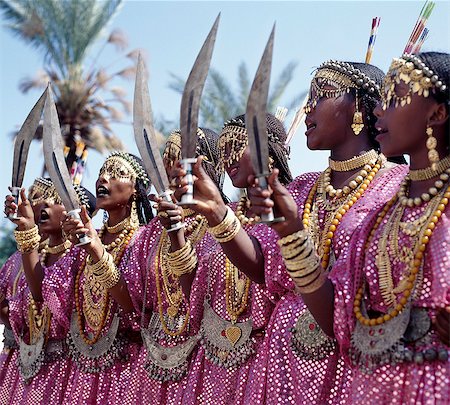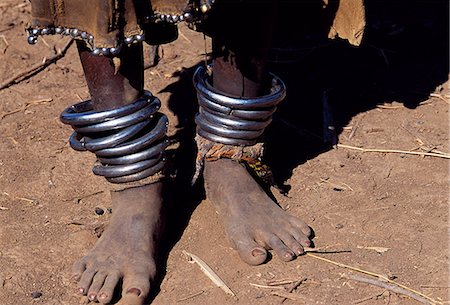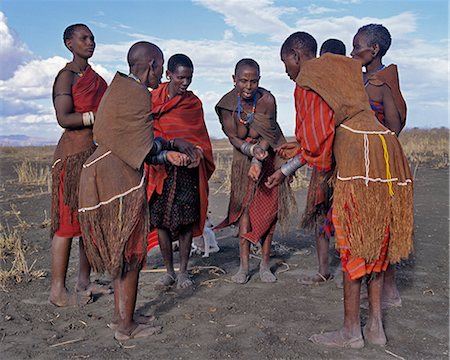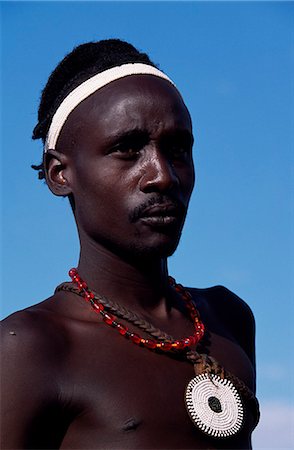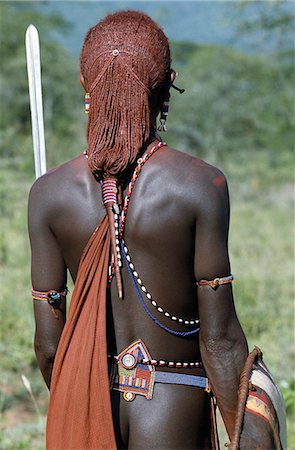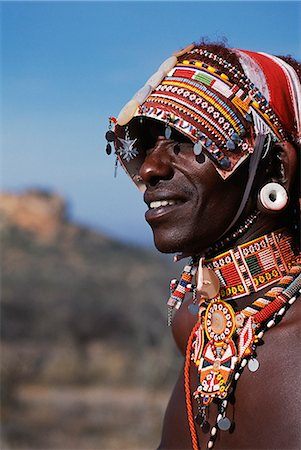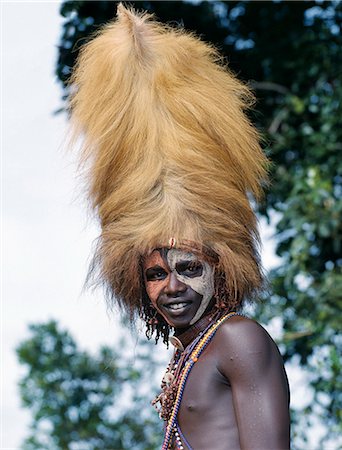-
The ornaments of a Pokot warrior including a ring of goat skin which would have been slaughtered for a ceremony. The Pokot are pastoralists speaking a Southern Nilotic language.
Rights-Managed
-
A pretty Borana girl at Mega in southern Ethiopia wears brightly coloured cotton cloth and numerous strings of beads. The pastoral Borana live either side of the southern Ethiopian/northern Kenya border and form a large and important group of the Oromo-speaking cluster of tribes.
Rights-Managed
-
A young Dassanech girl wears a leather skirt,metal bracelets and amulets and layers of bead necklaces. Much the largest of the tribes in the Omo Valley numbering around 50,000,the Dassanech (also known as the Galeb,Changila or Merille) are Nilotic pastoralists and agriculturalists.
Rights-Managed
-
A Maasai warrior,his face and body decorated with red ochre and clay,wears an ostrich feather headdress. This singular adornment was once worn by warriors going into battle and was likely designed to frighten an enemy.
Rights-Managed
-
A young married Pokot woman wearing the traditional beaded ornaments of her tribe which denote her married status. The Pokot are pastoralists speaking a Southern Nilotic language.
Rights-Managed
-
Karo men excel in body art. They decorate their faces and torsos elaborately using local white chalk, pulverised rock and other natural pigments. Their braided hairstyles are typical of young men from the tribe.The Karo are a small tribe living in three main villages along the lower reaches of the Omo River in southwest Ethiopia.
Rights-Managed
-
Black clothing,Black ostrich feathers and the intricate white patterns on the face of this Maasai youth of the Kisongo section signify his recent circumcision.
Rights-Managed
-
An Afar girl with braided hair has very noticeable scarification on her cheeks. Scarification is practiced in only a few sections of her tribe. Proud and fiercely independent,the nomadic Afar people live in the low-lying deserts of Eastern Ethiopia.
Rights-Managed
-
A Dassanech girl braids her sister's hair at her village in the Omo Delta. Much the largest of the tribes in the Omo Valley numbering around 50,000,the Dassanech (also known as the Galeb,Changila or Merille) and Nilotic pastoralists and agriculturalists.
Rights-Managed
-
An attractive girl from the Kediyo tribe carries a large,beautifully made umbrella. Its wooden frame is covered with the dried leaves of ensete,the false banana plant (seen growing in the background). Widely cultivated in southern Ethiopia,ensete roots and stems,which are rich in carbohydrates,are either cooked and eaten as a porridge or made into bread.
Rights-Managed
-
A young Afar girl at Filwoha in the Awash National Park. Filwoha in the Afar language means 'hot water'. The beautiful springs are surrounded by doum palms and rise from deep underground at about 96.8 degrees F.
Rights-Managed
-
An Afar girl has her attractive hairstyle embellished with buttons and beads,which is typical of the young girls of her tribe. Proud and fiercely independent,the nomadic Afar people live in the low-lying deserts of Eastern Ethiopia.
Rights-Managed
-
Samburu girls are given strings of beads by their fathers when they are still young. As soon as they are old enough to have lovers from the warrior age set, they regularly receive gifts from them.Over a period of years, their necklaces can smother them up to their necks.
Rights-Managed
-
A Karo woman with her face painted in preparation for a dance in the village of Duss. A small Omotic tribe related to the Hamar, who live along the banks of the Omo River in southwestern Ethiopia, the Karo are renowned for their elaborate body painting using white chalk, crushed rock and other natural pigments. She is wearing a goatskin apron and carries a leather belt decorated with cowrie shells
Rights-Managed
-
A Karo women stands in the doorway to her hut in the village of Duss. A small Omotic tribe related to the Hamar, who live along the banks of the Omo River in southwestern Ethiopia, the Karo are renowned for their elaborate body painting using white chalk, crushed rock and other natural pigments. In addition to painting her face she has decorated her body with whorls of goat hair tied by leather co
Rights-Managed
-
An Afar girl from the Sultanate of Tadjoura wears exotic gold jewellery for marriage and other important celebrations. Although some of this jewellery will be made locally,other pieces will have been bought in Arabia,Ethiopia and the Indian sub-continent.
Rights-Managed
-
A young Dassanech girl wears a leather skirt,metal bracelets and amulets and layers of bead necklaces. A long leather strap decorated with cowrie shells hangs down her back. Much the largest of the tribes in the Omo Valley numbering around 50,000,the Dassanech (also known as the Galeb,Changila or Merille) are Nilotic pastoralists and agriculturalists.
Rights-Managed
-
A Pokot warrior wearing a leopard skin cape celebrates an Atelo ceremony, spear in hand. The Pokot are pastoralists speaking a Southern Nilotic language.
Rights-Managed
-
Samburu girls are given strings of beads by their fathers when they are still young. As soon as they are old enough to have lovers from the warrior age-set,they regularly receive gifts from them. Over a period of years,their necklaces can smother them up to their necks. The metal cross-like ornament hanging from the girl's headband has no religious significance.
Rights-Managed
-
A young Pokot girl wearing a traditional broad necklace made of hollow reed grass that denotes her uninitiated status. The Pokot are pastoralists speaking a Southern Nilotic language.
Rights-Managed
-
Pokot women wearing traditional beaded ornaments and brass earrings denoting their married status. celebrate an Atelo ceremony. The Pokot are pastoralists speaking a Southern Nilotic language.
Rights-Managed
-
Kenya, Samburu District. Young Samburu girl in traditional beaded necklaces.
Rights-Managed
-
A young Datoga boy attired in beads. The metal bells worn around his ankles ensure that he does not wander far from home without his mother or another member of the family hearing him. The Datoga (known to their Maasai neighbours as the Mang'ati and to the Iraqw as Babaraig) live in northern Tanzania and are primarily pastoralists.
Rights-Managed
-
Two young Datoga boys. The youngest wears metal bells around his ankles to ensure that he does not wander far from home without his mother or another member of the family hearing him. The Datoga (known to their Maasai neighbours as the Mang'ati and to the Iraqw as Babaraig) live in northern Tanzania and are primarily pastoralists.
Rights-Managed
-
A Karo woman wears an elaborate headdress made from the wing-cases of beetles and a cape of calf skin fringed with cowrie shells. A small Omotic tribe related to the Hamar,who live along the banks of the Omo River in southwestern Ethiopia,the Karo are renowned for their elaborate body painting using white chalk,crushed rock and other natural pigments.
Rights-Managed
-
A young Ethiopian girl with unusual braided hair; the crown of her head has been smeared with a greenish substance. Her two pendants are made from Maria Theresa thalers old silver coins minted in Austria,which were widely used as currency in northern Ethiopia and Arabia until the end of World War II.
Rights-Managed
-
A Maasai warrior has daubed himself with red ochre mixed with animal fat to participate in a dance. His long ochred braids have been drawn forward from the crown of the head and tied in three places. This singular hairstyle sets warriors apart from the rest of their society.
Rights-Managed
-
A Karo woman sits with child. A small Omotic tribe related to the Hamar,who live along the banks of the Omo River in southwestern Ethiopia,the Karo are renowned for their elaborate body painting using white chalk,crushed rock and other natural pigments. Typically for a Karo woman,the mother has ochred her hair in tight ringlets and has a ring through her bottom lip.
Rights-Managed
-
A young Dassanech girl holds her little brother. She wears a leather skirt with an elaborate fringe of wooden and metal tassles. Much the largest of the tribes in the Omo Valley numbering around 50,000,the Dassanech (also known as the Galeb,Changila or Merille) are Nilotic pastoralists and agriculturalists.
Rights-Managed
-
Karo men excel in body art. Before a dance, they will decorate their faces and torsos elaborately using local white chalk, pulverised rock and other natural pigments. While older men style their hair with clay, young men prefer to braid theirs.Every man carries a wooden stool, which doubles as a pillow at night.The Karo are a small tribe living in three main villages along the lower reaches of the
Rights-Managed
-
Karo men excel in body art. They decorate their faces and torsos elaborately using local white chalk, pulverised rock and other natural pigments. Their braided hairstyles are typical of young men from the tribe.The Karo are a small tribe living in three main villages along the lower reaches of the Omo River in southwest Ethiopia.
Rights-Managed
-
A Dassanech man in full tribal regalia participates in a dance during a month long ceremony. He wears a cheetah skin draped on his backs and a black ostrich feather headdress. He dances holding a long stick and a simulated shield.His face is smeared with mud giving him a singular appearance.
Rights-Managed
-
A Maasai warrior resplendent with long ochred braids. His body has been smeared with red ochre mixed with animal fat while parts of his face have been covered with ochre powder.
Rights-Managed
-
A young Dassanech girl wears a beautiful array of beaded necklaces,some secured at the back by metal rings,and a beaded headband. Her ears are pierced several times,the holes are kept open by small wooden plugs. Much the largest of the tribes in the Omo Valley numbering around 50,000,the Dassanech (also known as the Galeb,Changila or Merille) are Nilotic pastoralists and agriculturalists.
Rights-Managed
-
A young Karo girl in the doorway of her hut in the village of Duss. A small Omotic tribe related to the Hamar,who live along the banks of the Omo River in southwestern Ethiopia,the Karo are renowned for their elaborate body painting using white chalk,crushed rock and other natural pigments.
Rights-Managed
-
A Maasai elder in traditional attire. Red has always been the preferred Maasai colour. Bell-shaped brass earrings are typically worn by the elders of the tribe.
Rights-Managed
-
A Samburu woman wearing a mporro necklace,which signifies her married status.These necklaces,once made of hair from giraffe tails,are now made from fibres of doum palm fronds (Hyphaene coriacea). The beads are mid-19th century Venetian glass beads,which were introduced to Samburuland by early hunters and traders.
Rights-Managed
-
A close-up of a Pokot woman's earrings,hairstyle and beaded ornaments. Only married women wear brass earrings and glass-beaded collars. The band over her head supports the weight of her heavy earrings.
Rights-Managed
-
Men and women dance during a month long Dassanech ceremony. The men wear leopard, cheetah or serval cat skins draped on their backs and black ostrich feather headdresses. The women, dressed in skins, hang a single black and white colobus monkey skin down their backs.
Rights-Managed
-
During a dance,Muslim girls from the Sultanate of Tadjoura,dress up in all their finery and display the curved daggers of their men.
Rights-Managed
-
A young Dassanech girl wears heavy metal anklets beneath her beaded leather skirt. Much the largest of the tribes in the Omo Valley numbering around 50,000,the Dassanech (also known as the Galeb,Changila or Merille) are Nilotic pastoralists and agriculturalists.
Rights-Managed
-
A young Datoga man tends his family's livestock on the plains east of Lake Manyara in Northern Tanzania.The Datoga (known to their Maasai neighbours as the Mang'ati and to the Iraqw as Babaraig) live in northern Tanzania and are primarily pastoralists..
Rights-Managed
-
A Hadza girl wearing a beaded headband and necklaces.The Hadzabe are a thousand-strong community of hunter-gatherers who have lived in the Lake Eyasi basin for centuries. They are one of only four or five societies in the world that still earn a living primarily from wild resources.
Rights-Managed
-
Black clothing and the intricate white patterns on the face of this Maasai youth of the Kisongo section signify his recent circumcision.
Rights-Managed
-
A Nyangatom woman wears multiple layers of beads in necklaces, an elaborately beaded calfskin skirt and metal bracelets, amulets and anklets. She is standing beside a temporary beehive construction of sticks, grass and leaves built to provide shade for her goats. The Nyangatom or Bume are a Nilotic tribe of semi-nomadic pastoralists who live along the banks of the Omo River in south western Ethio
Rights-Managed
-
Pokot women and girls dancing to celebrate an Atelo ceremony. The Pokot are pastoralists speaking a Southern Nilotic language.
Rights-Managed
-
Samburu girls are given strings of beads by their fathers when they are still young. As soon as they are old enough to have lovers from the warrior age-set,they regularly receive gifts from them. Over a period of years,their necklaces can smother them up to their necks. The metal cross-like ornament hanging from the girl's headband has no religious significance.
Rights-Managed
-
Pokot women and girls dancing to celebrate an Atelo ceremony. The Pokot are pastoralists speaking a Southern Nilotic language.
Rights-Managed
-
A Maasai warrior blows a trumpet fashioned from the horn of a Greater Kudu. The strap is decorated with cowrie shells. Kudu-horn trumpets are only sounded to call men to arms or on ceremonial occasions.
Rights-Managed
-
A young Pokot girl in traditional attire. Girls wear leather skirts and capes made from home-tanned goatskins. Her broad necklaces are made from small segments of sedge grass. Her ears have already been pierced in four places,ready to insert the large brass earrings she will acquire after marriage.
Rights-Managed
-
Two young Karo girls stand in front of the massive trunk of a fig tree. A small Omotic tribe related to the Hamar,who live along the banks of the Omo River in southwestern Ethiopia,the Karo are renowned for their elaborate body painting using white chalk,crushed rock and other natural pigments.
Rights-Managed
-
A Mursi woman wearing a large clay lip plate. Shortly before marriage, a girls lower lip will be pierced and progressively stretched over a year or so. The size of the lip plate often determines the quantum of the bride price. They live in a remote area of southwest Ethiopia along the Omo River, the country's largest river.
Rights-Managed
-
A Nyangatom woman wearing an elegant skirt with a short beaded fringe at the font and long calfskin tail reaching the ground at the back. This woman has a broad belt decorated with cowrie shells. The Nyangatom or Bume are a Nilotic tribe of semi-nomadic pastoralists who live along the banks of the Omo River in south-western Ethiopia.
Rights-Managed
-
A Dassanech man shows off his distinctive painted clay hairdo. The central panel consists of tightly packed coils of sisal thread extracted from grain sacks that allow the scalp to breathe underneath the clay. The scarification on his chest indicates that he has killed a man in combat. Much the largest of the tribes in the Omo Valley numbering around 50,000, the Dassanech, also known as the Galeb,
Rights-Managed
-
Kenya,Kajiado,Maparasha. A Maasai warrior resplendent with long,ochred braids. This singular form of hairstyle distinguishes warriors from the rest of their society. This man has looped his elongated and decorated earlobes over his ears - a common practice when walking through thorn scrub country to prevent the loops being snagged by thorns.
Rights-Managed
-
Old Datoga women wearing beautifully tanned and decorated leather dresses sing a short distance from their homes. They keep rhythm by rubbing their numerous iron bracelets together.The Datoga (known to their Maasai neighbours as the Mang'ati and to the Iraqw as Babaraig) live in northern Tanzania and are primarily pastoralists.
Rights-Managed
-
A Pokot woman wearing the traditional beaded ornaments of her tribe which denote her married status. The Pokot are pastoralists speaking a Southern Nilotic language.
Rights-Managed
-
A Karo woman wears an elaborate headdress made from the wing-cases of beetles and a cape of calf skin fringed with cowrie shells. A small Omotic tribe related to the Hamar,who live along the banks of the Omo River in southwestern Ethiopia,the Karo are renowned for their elaborate body painting using white chalk,crushed rock and other natural pigments.
Rights-Managed
-
A young Dassanech girl wears a beautiful array of beaded necklaces. Much the largest of the tribes in the Omo Valley numbering around 50,000,the Dassanech (also known as the Galeb,Changila or Merille) are Nilotic pastoralists and agriculturalists.
Rights-Managed
-
A Dassanech man shows off his distinctive hairdo and ornamentation. Much the largest of the tribes in the Omo Valley numbering around 50,000,the Dassanech (also known as the Galeb,Changila or Merille) are Nilotic pastoralists and agriculturalists.
Rights-Managed
-
An elder of the Karo tribe,a small Omotic tribe related to the Hamar,who live along the banks of the Omo River in southwestern Ethiopia. The Karo are renowned for their elaborate body painting using white chalk,crushed rock and other natural pigments. This man also has a clay hairdo typical of tribal elders. Like most adult males he carries a rifle.
Rights-Managed
-
Kenya, Samburu District. A Samburu woman, wearing intricate beaded necklaces, leans against her mud hut towards the end of the day.
Rights-Managed
-
An old Datoga woman. Her traditional attire includes a beautifully tanned and decorated leather dress . The Datoga (known to their Maasai neighbours as the Mang'ati and to the Iraqw as Babaraig) live in northern Tanzania and are primarily pastoralists.
Rights-Managed
-
A Hadza woman digs for edible tubers with a digging stick.The Hadzabe are a thousand-strong community of hunter-gatherers who have lived in the Lake Eyasi basin for centuries. They are one of only four or five societies in the world that still earn a living primarily from wild resources.
Rights-Managed
-
Two young Samburu girls help each other preparing for a celebration,Wamba District,Kenya
Rights-Managed
-
Pokot warriors celebrate an Atelo ceremony. The Pokot are pastoralists speaking a Southern Nilotic language.
Rights-Managed
-
A Samburu woman singing. The strings of black and white beads hanging from her ears signify that she has two grown-up sons who are warriors of the tribe. Note: the traditional horn snuff container hanging from her neck.
Rights-Managed
-
A back view of a Maasai warrior resplendent with long ochred braids tied in a pigtail. This singular hairstyle sets him apart from other members of his society. His beaded belt is of a style only worn by warriors. The little copper bell-shaped ear ornament hanging from his elongated and decorated earlobe is also peculiar to the Maasai.
Rights-Managed
-
A Datoga woman relaxes outside her thatched house.The traditional attire of Datoga women includes beautifully tanned and decorated leather dresses and coiled brass armulets and necklaces.The Datoga live in northern Tanzania and are primarily pastoralists.
Rights-Managed
-
Elaborate headdress and body adornments worn by Samburu moran (warrior).
Rights-Managed
-
A Nyangatom mother and young daughter in typical dress. Rugged skin clothing is still widely used.The Nyangatom are one of the largest tribes and arguably the most warlike people living along the Omo River in Southwest Ethiopia.
Rights-Managed
-
A young Turkana girl wearing an attractively beaded leather apron and belt stands outside her mother's home. Sansevieria or wild sisal lines the lower walls of the house. Cicatrization round the nipples of a girl is not an uncommon form of beautification.
Rights-Managed
-
A Maasai warrior in full regalia. He has stuck a porcupine quill in his beaded headband to add to his other decorations. His long,Ochred plaits have been drawn forward from the crown of his head and tied in three bunches.
Rights-Managed
-
A young Dassanech girl holds her little brother. She wears a leather skirt with an elaborate fringe of wooden and metal tassles. Much the largest of the tribes in the Omo Valley numbering around 50,000,the Dassanech (also known as the Galeb,Changila or Merille) are Nilotic pastoralists and agriculturalists.
Rights-Managed
-
A young married Pokot woman wearing the traditional beaded ornaments of her tribe which denote her married status. The Pokot are pastoralists speaking a Southern Nilotic language. Kenya
Rights-Managed
-
Kenya,Trans-Mara,Lolgorien. The Maasai do not eat game meat or birds. Consequently,the wildlife in their vast grazing areas has been left relatively undisturbed. The warriors do hunt lions,however,when their cattle are killed. The warrior who spears a lion to death will make a busby-style headdress from its mane.
Rights-Managed
-
A Mursi woman wearing a large wooden lip plate. Shortly before marriage, a girls lower lip will be pierced and progressively stretched over a year or so. The size of the lip plate often determines the quantum of the bride price. They live in a remote area of southwest Ethiopia along the Omo River.
Rights-Managed
-
An elder of the Karo tribe,a small Omotic tribe related to the Hamar,who live along the banks of the Omo River in southwestern Ethiopia. The Karo are renowned for their elaborate body painting using white chalk,crushed rock and other natural pigments. This man also has a clay hairdo typical of tribal elders. Like most adult males he carries a rifle.
Rights-Managed
-
Karo men excel in body art. They decorate their faces and torsos elaborately using local white chalk, pulverised rock and other natural pigments.While young men prefer to braid their hair, older men style their hair with clay, which they colour and decorate with ostrich feathers.The Karo are a small tribe living in three main villages along the lower reaches of the Omo River in southwest Ethiopi
Rights-Managed


